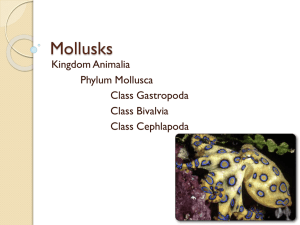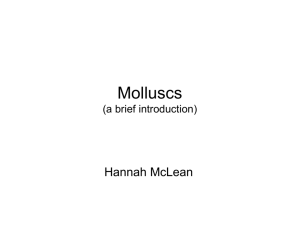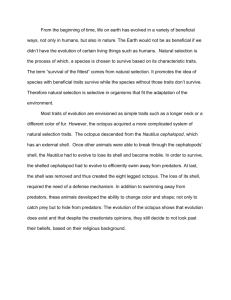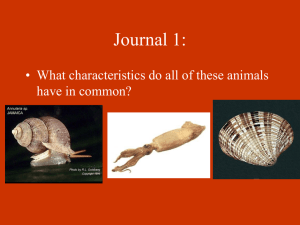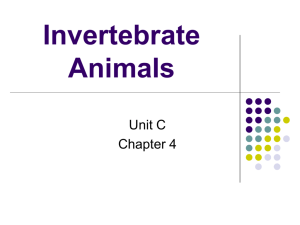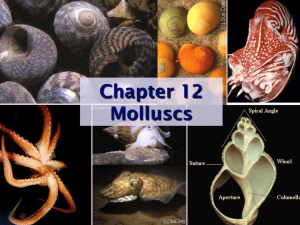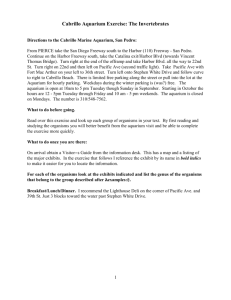Invertebrates
advertisement
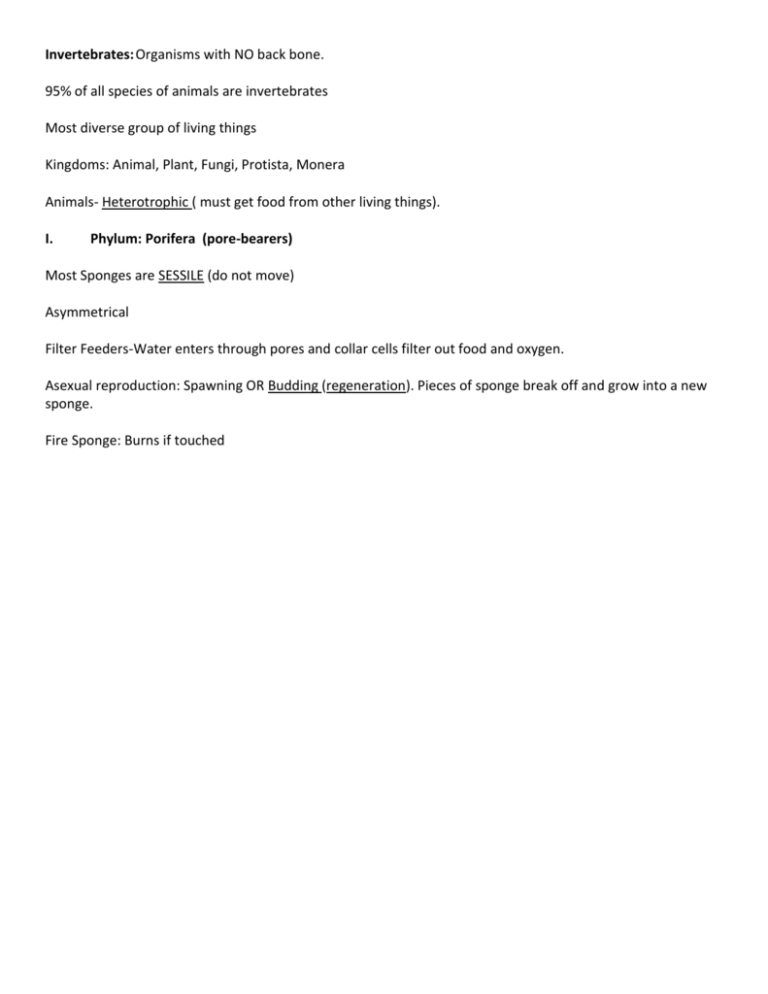
Invertebrates: Organisms with NO back bone. 95% of all species of animals are invertebrates Most diverse group of living things Kingdoms: Animal, Plant, Fungi, Protista, Monera Animals- Heterotrophic ( must get food from other living things). I. Phylum: Porifera (pore-bearers) Most Sponges are SESSILE (do not move) Asymmetrical Filter Feeders-Water enters through pores and collar cells filter out food and oxygen. Asexual reproduction: Spawning OR Budding (regeneration). Pieces of sponge break off and grow into a new sponge. Fire Sponge: Burns if touched Invertebrates: Organisms with NO back bone. 95% of all species of animals are invertebrates Most diverse group of living things Kingdoms: Animal, Plant, Fungi, Protista, Monera Animals- Heterotrophic ( must get food from other living things). II. Phylum: Mollusca Ex: Clam, Mussel, Oyster, Squid, Octopus, Snail, Sea Slug, Nudibranch. Mollusk- Soft-bodied organisms surrounded by a hard protective shell. ** Some have evolved so their shell is internal ** Mantle-thin layer of tissue that secretes a shell Foot-Ventrally located, muscular foot for locomotion/burrowing. Breath oxygen through gills Classes of Mollusk: Gastropods, Bivalves, Cephalopods 1. Gastropod ( Stomach-Footed) Ex: Snails, Slugs, Nudibracnches, Limpets Largest group of mollusks ` 90,000 species !!! Shell rests on a foot. Organs enclosed by a dorsal shell. Reproduction: A. Some are hermaphrodites (male and female gonads). Perform sexual reproduction through copulation. Flexible penis is very long. B. Others spawning (male release sperm, female release eggs into water). 2. Bivalves – Two Valves Ex. Clams, Oysters, Mussels, Scallops Soft-bodied organisms with TWO shells. Filter-Feeders ( separate food and oxygen out of the water). They are excellent at cleaning the seas!! Gills-Take oxygen out of the water. Open-Circulatory system, blood flows through organisms without veins and arteries. Reproduction: Spawning: Male release sperm into water, female release eggs into water. They fertilize in water and fertilized egg settles to seafloor. Movement is limited, most are Sessile. Some Burrow with their foot, others attach to rocks and surfaces using strong byssal threads (ie. Mussels). Pearls form in oysters when an irritant (sand) gets stuck between its shell and mantle tissue. Nacre (motherof-pearl) grows over the irritant and produces a Pearl. III. Phylum: Mollusca 3. Cephalopod- Head-Footed Ex. Squid, Octopus, Cuttlefish How are these mollusks different from the bivalves and gastropods?? No hard outer shell, Appear to have arms/foot, are very mobile… No outer shell-Shell evolved to be INTERNAL/ protected by a hard mantle. More advanced: Complex Nervous System (detect predators and senses movement, change, etc.). Tentacles with suckers capture and hold prey. Mobile Closed Circulatory System. Sexual Reproduction: Copulation. Male transfers a sperm packet into the female- Internal Fertilization. A. Octopus: 8 arms No SHELL - can squeeze into TINY places!! Demersal “walks/crawls” along the bottom (poor swimmers) Diet of shrimp, crab, lobster (other demersal organisms) Distract prey by shooting INK & Camouflage AVOID: Blue Ring Octopus ( poisonous) B. Squid: 10 arms ( 2 are longer and retractable with suckers ONLY on the ends. Reach out to grab hold of prey and pull it into its mouth. Pelagic Better swimmers than octopus and can remain motionless! Jet Propulsion-Force water into the gills and out of the funnel. Moves in ANY DIRECTION at high speeds! Reduced shell (internal) called a PEN. Range in size from a few centimeters to 66ft or more (Giant Squid) Diet of shrimp, crab, lobster. Distract prey by shooting INK & Camouflage ( Largest Invertebrate) C. Cuttlefish: Similar to squid-10 arms, but have broader body Masters of camouflage! Distract prey by shooting INK & Camouflage Shell-like bone inside (cuttle-bone). Live near shore. Very short-lived

